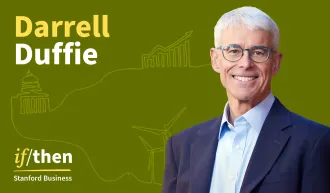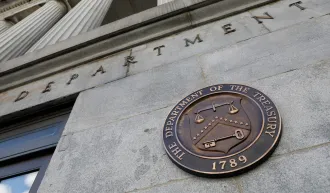Research-Backed Ways to Get Out the Vote
How lessons from behavioral science could help increase turnout.
April 17, 2012

A voter outside a polling place during the U.S. midterm elections in 2006 | REUTERS/Brian Snyder
Researchers applying psychology to the realm of politics are finding that giving voters a few strategic nudges can push far more people in the direction of polls on election day.
Old standard “get-out-the-vote” phone call scripts made by volunteers simply asked people to participate in the election and reminded callers that voting was important. But now, using insights on how people make decisions, political parties and other organizations are finding that subtle changes in language — even from a verb to a noun — can make a substantial difference in how many people cast ballots.
Studies presented at Stanford on March 30 showed that more voters are motivated to go to the booths when they are told turnout will be high and when they are provoked to discuss plans for getting there. Moreover, they also are more likely to vote when they are threatened with personal accountability and when they are encouraged to see voting as an intrinsic part of their identity, rather than just “something they do.”
Since the 2006 election, in fact, organizations have doubled or tripled the efficiency of their get-out-the-vote budgets by including such messages, according to Todd Rogers, a Harvard professor and former founding executive director of the political research organization Analyst Institute. Rogers presented the work to nonprofit and corporate leaders assembled for “The Science of Getting People to Do Good” briefing, sponsored by the Center for Social Innovation at Stanford GSB.
Typical voter campaign telephone scripts just encouraging people to vote, Rogers said, end up being a total waste of time and have no impact on voting behavior. What works in such calls, instead, is getting people to form a voting plan.
In a controlled study of voter mobilization phone calls in the 2008 Pennsylvania presidential primary, which pitted Hillary Clinton against Barack Obama, researchers discovered that differences in scripts affected turnout. Scripts that guided people to think through the logistical details of their plans for voting — such as when they intended to head to the polls, how they would get there, and what they would be doing beforehand — were more than twice as effective as the standard scripts that simply asked people if they intended to vote.
“This shows that cognitive planning and mechanical logistics, not just motivation, are part of the voting decision,” Rogers noted. But the plan-making only affected single-voter households. “Voters who live alone are less likely to have a plan than people who live in groups or families, where discussing the next days’ events are a natural part of life. So the intervention has much more impact on those who live alone,” Rogers said.
Personal accountability matters, too. In a study of the 2010 general election, researchers sent one group of potential voters a psychologically sophisticated mailing encouraging them to vote. Another group received the same mailing, plus in the top right corner a box saying: “We may call you after the election to talk about your voting experience.” Adding that box increased the effectiveness of the mailing in terms of the voting it stimulated by almost half. The effect was especially strong among those who were the most civically engaged, based on their answers to a post-election survey of civic questions like: “How many amendments are there in the Bill of Rights?”
Join the Trend or Buck the Trend?
A common tactic used by press, politicians, and pundits to get people to vote has simply been to lament low voter turnout. But, Rogers has conducted research showing that such messages actually demotivate voting. “This is because people are fundamentally social beings, and so the behavior of others influences their behavior,” he explained.
Two get-out-the-vote field experiments found that messages emphasizing low expected turnout were less effective at motivating voters than those emphasizing high expected turnout. But the effect was found only among citizens who voted infrequently or occasionally. “The results suggest that perhaps the reason political professionals use low- turnout messaging so often is because they, as regular voters, find it just as motivating as high-turnout messaging,” Rogers said. Practically speaking though, the results suggest voter mobilization efforts should emphasize high turnout, especially when targeting occasional and low-participation voters.
In another study, researchers showed that people are more likely to head for the ballots when they are encouraged to see voting as a noble aspect of their character. One way to do this is to use nouns rather than verbs. One version of a survey conducted online used a self-relevant noun. (“How important is it to you to be a voter in the upcoming election?”) Another referred to voting using a verb (“How important is it to you to vote in the upcoming election?”) The noun/personal-identity phrasing increased interest in registering to vote in two statewide elections in the United States and increased turnout in a third study, as assessed by official state records. The subtle message that voting affirms a virtuous part of a person’s identity seems to work.
“By leveraging the insights of behavioral science,” Rogers concluded, “this research will make the hundreds of millions of dollars spent mobilizing voters in this presidential election year dramatically more potent, improving the stability, legitimacy, and representativeness of our democracy.”
By featuring this work in a public forum, the Stanford GSB briefing exposed nonprofit and corporate leaders to research that encourages people to behave in ways that benefit themselves, their peers, and their communities. Other studies looked at how to close the achievement gap in schools with just simple self-esteem building interventions, how to encourage people to lose weight and improve their health, and how to get people to recycle and promote peace and reconciliation.
The voting behavior studies shared at the briefing can be found here.
For media inquiries, visit the Newsroom.
Explore More

Yes “We” Can: Swapping Pronouns Can Make Messages More Persuasive

Is That Self-Driving Car a Boy or a Girl?



